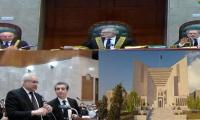We review the issue of women’s political participation in metropolises and link it to the need for empirical research. This article refers to some literature (mainly Cheema et al 2019; also NCSW 2018) to illustrate the discussion.
Some of the empirical research we discuss in this article has already been explained in an earlier article in these pages on April 2, 2019 on the basis of another publication by Cheema et al (IDS, February 2019). Today, we are going to expand discussion on those aspects of the research that are discussed in the IDEAS’ version (April 2019) and have not been discussed in detail in my earlier article.
A takeaway from the research is that there is a strong case for empirical research in the social sciences. Cheema et al (2019)’s paper published by IDEAS relies on two surveys; IDEAS-A4EA Baseline Citizen Survey was conducted in 2018 covering 2,500 households (two respondents per household: one woman and one man) selected randomly in seven out of total 14 Lahore constituencies’ of the National Assembly, and one third of electoral wards of the metropolis; and a Turnout Survey. The latter survey of women and men was conducted within the two days of the July 2018 Elections.
Pakistan in total has 105.9 million registered voters; 44 percent women and 56 percent men, and it shows that roughly 12 million women are yet ‘missing’ as voters. This is despite the fact that 19.7 million (10.6 million men and 9.1 million women) were made part of the electoral rolls in the five years between 2013 and 2018.
However, other than voter registration, another equally big challenge is voter turnout. The men-women voter turnout gap was 9.1 percent in the 2018 elections with ‘11 million fewer women exercising their right to vote than men’. In terms of intra-provincial variation in voter turnout, the largest cities in each province have a bigger gender gap in voter turnout in comparison with the remaining provincial average for the other constituencies. This gender gap in voter turnout is highest in Punjab, and Lahore’s 12.5 percent gap is almost twice as much compared to the rest of the province (6.3 percent).
Section 9 of the Elections Act 2017 stipulates that if women have been barred in any polling station/s or constituency (for example, if women’s turnout is less than 10 percent in any constituency), the ECP may declare the election null and void, and may order a re-poll in those polling station/s or constituency. However, according to Cheema et al (2019), this progressive clause of the Elections Act 2017 may only cater to the situation (more rural) where women have been restrained from voting by the community, group or local elite. Yet, those community dynamics are not applicable in a big metropolis like Lahore, and the gendered household dynamics interact with the ‘gendered political space’ and contribute to low women voter turnout.
In terms of ‘gendered household space’, men are ‘gatekeepers’ of women’s engagement with politics; and women need to get ‘permission’ from men when they are going to public places. Women easily get permission to go to the market for personal shopping needs, and the majority of women and men do not object to women exercising their right to vote. Yet the majority (or near majority) of men do not find it unfavourable if someone doesn’t supporting women voting in elections if it interferes with household responsibilities, or if women would want to vote differently than men, or if there are fears of unrest at polling stations. Women have divergent views on this, except the unrest issue. The norms and attitudes of men in a household to an important extent play a role in women’s decision to vote or not.
Similarly, the ‘political space’ in a big metropolis like Lahore functions on gender segregated lines and there is ‘low contact’ between political party representatives, political workers, and women. Women have less political knowledge and ‘self-efficacy’ than men. Fewer women attend corner meetings and political rallies, and the majority of men (64 percent) are not in favour of women becoming political party workers. Women feel politically ‘invisible’ and do not cultivate interest in politics. Women are being ‘socialized’ as less politically aware members of society which is statistically correlated with their low turnout in the elections.
This research presents a more nuanced understanding of low women voter turnout in the big city context rather than only explaining it through the culture of segregation. However, we still feel that patriarchy explains the underlying reasons behind the ‘gendered household space’ and ‘gendered political space’. Women are often not considered autonomous and independent citizens with a distinct identity of their own, other than their family affiliation. Unless women and men can bridge the gap of patriarchal structures, symptoms like low women voter turnout may persist.
In terms of the way forward, for all concerned stakeholders in women’s political participation, there is a need to adopt the ‘radical agenda for action’ to reverse women’s somewhat apolitical socialization, given the fact that voter education campaigns as they have been administered are not too effective in contributing to women’s political knowledge and interest, or helping them overcome with the gendered nature of political space.
In terms of recommendations, the Elections Act 2017 could be amended further to increase the threshold of women’s vote that a candidate must be polled to win the elections. It may push the political parties to engage meaningfully with women and their developmental and service delivery concerns.
A further affirmative action to allocate seats for women for mayoral office and ministerial posts could help build women’s political leadership. Similarly, women’s role can also be promoted by instituting ‘women’s citizens’ collectives’ where they can audit delivery of public services and the budgeting process.
The writer is an Islamabad-based social scientist.
Any progressive society or government will uphold security so that people can utilize their full potential
In Pakistan, we have witnessed erosion of public trust in government institutions
Capability, accountability, and responsiveness don’t quite capture the increasingly important issue of legitimacy
The government can directly influence economic activity through current and capital expenditure
A view of the Supreme Court of Pakistan. — Supreme Court website/FileWhat kind of firewall does the judiciary...
Indian soldiers stand alongside a barbed wire on the Line of Control. — AFP/FileAnti-Pakistan propaganda remains a...







